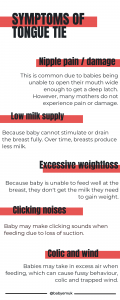Today I want to talk to you about how breastfeeding can be impacted by a tongue tie.
What is a tongue tie?
A tongue tie is a lingual frenulum associated with breastfeeding difficulties. A lingual frenulum is a normal part of the development of the mouth and tongue. When the lingual frenulum is short and/or tight, this may lead to problems with breastfeeding. A tongue tie is also known as ankyloglossia.
How common is it?
Tongue ties are said to occur in around 1 in 20 babies. They can have a marked impact on breastfeeding. Studies are inconsistent due to their differing assessment criteria and therefore estimates of how common a tie is can vary.
How does tongue tie impact breastfeeding?

As an IBCLC, I see very few babies with ties that are unable to breastfeed at all. With the right support, you can successfully feed a baby with tongue tie.
Many lactating parents experience symptoms such as nipple damage, misshapen nipples after a feed, blanching of the nipple, low milk supply and exhaustion. Some mothers experience feeding aversion or agitation as a result of the pain and discomfort.
The reason nipples get damaged during breastfeeding when baby has a tongue tie is because the tongue movement is restricted. This often means baby can't get a tight seal to create a vaccuum on the breast, and will slip off frequently. When they are on the breast the nipple gets compressed against the hard palette. Compression causes trauma and pain.
Symptoms for babies include excessive weight loss, fussy behaviour, colic, reflux, wind, and clicking noises during feeds.
This is not an exhaustive list! Many of these symptoms are indicative of poor position and attachment. A full feeding assessment by someone qualified should help rule out these issues before having a tongue tie assessment.
What should you do if you suspect a tongue tie?
First of all, a feeding assessment is required. If during the assessment there is suspicion of a tongue tie, a further assessment by someone appropriately qualified should then be done. There are a number of assessment tools used. A tongue tie practitioner will use a gloved hand to explore inside of the baby's mouth to assess oral function and suction. The elevation of the tongue will also be observed and assessed.
You can find an IBCLC here. You can find a tongue tie practitioner here.
If you are interested in learning more about Tongue Tie and Infant Feeding, our online course will help you to be able to better guide and support families who have babies with tongue-tie. The advanced syllabus will support you to gain a deeper understanding of the different types of tongue-tie, the assessment processes used and the possible treatment available.

